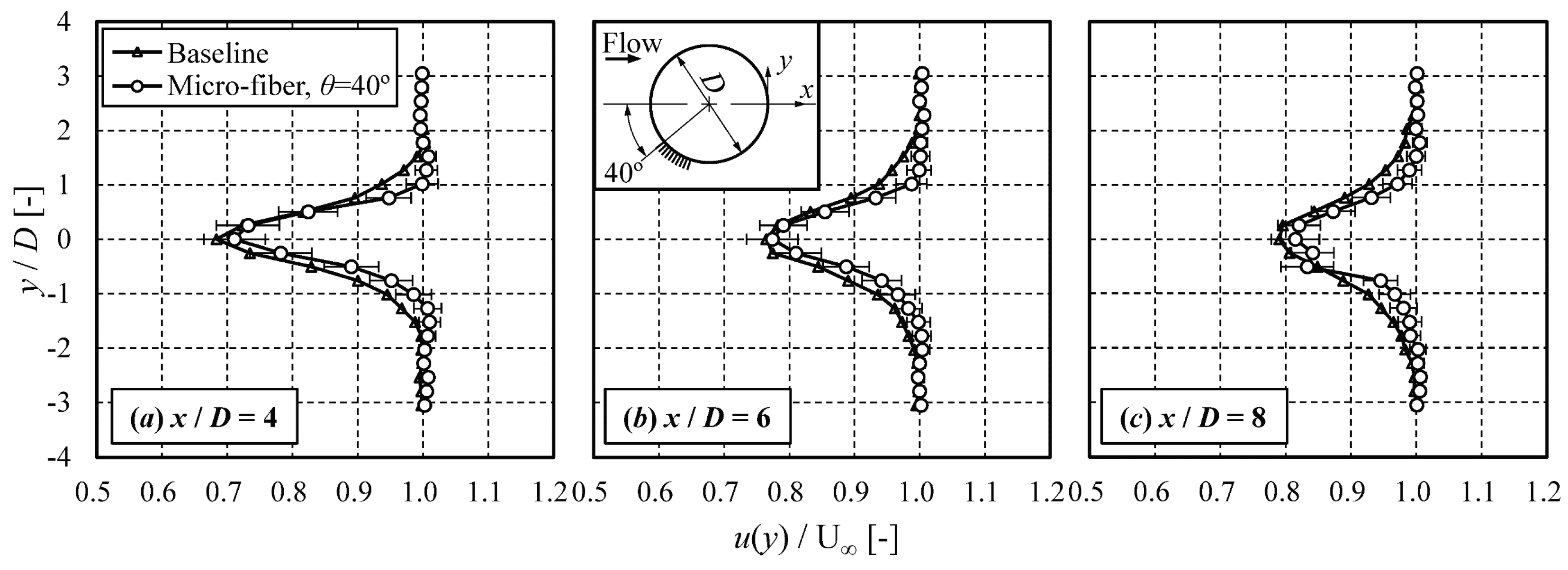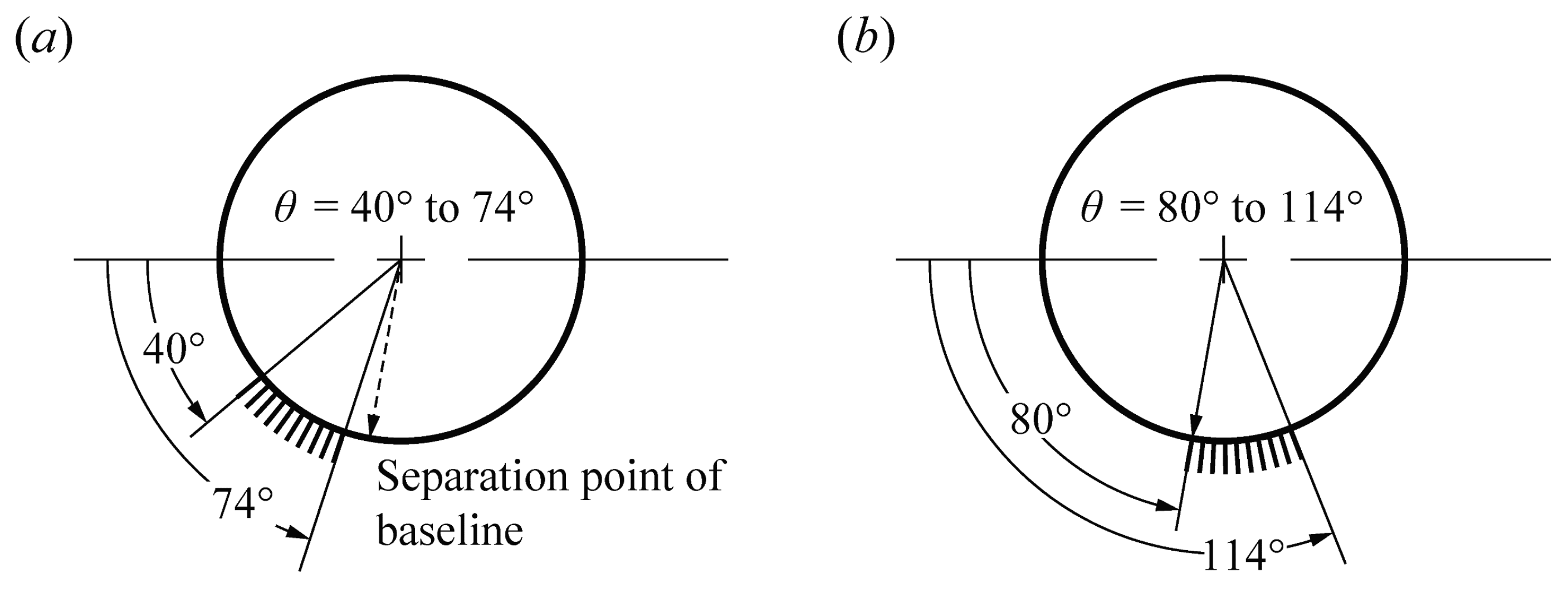Microfiber Coating for Drag Reduction by Flocking Technology
Abstract
:1. Introduction
2. Materials and Methods
2.1. Flow Visualization
2.2. Wake Survey
2.3. Drag Force Estimation
3. Results
3.1. Flow Visualization
3.2. Wake Survey
3.3. Drag Estimation
4. Conclusions
Author Contributions
Funding
Conflicts of Interest
References
- Thomas, F.O.; Kozlov, A.; Corke, T.C. Plasma actuators for cylinder flow control and noise reduction. AIAA J. 2008, 46, 1921–1931. [Google Scholar] [CrossRef]
- Kozlov, A.V.; Thomas, F.O. Bluff-body flow control via two types of dielectric barrier discharge plasma actuation. AIAA J. 2011, 49, 1919–1931. [Google Scholar] [CrossRef]
- Felder, W.N.; Dale, G.A.; Cash, C.; Chang, M. Prospects for the application of practical drag reduction technologies to legacy transport aircraft. In Proceedings of the 55th AIAA Aerospace Sciences Meeting, Grapevine, TX, USA, 9–13 January 2017. [Google Scholar]
- Achenbach, E. Distribution of local pressure and skin friction around a circular cylinder in cross-flow up to Re = 5 × 106. J. Fluid Mech. 1968, 34, 625–639. [Google Scholar] [CrossRef]
- Fage, A.; Warsap, J.H. The Effects of Turbulence and Surface Roughness on the Drag of a Circular Cylinder; H.M. Stationery Office: Richmond, UK, 1930. [Google Scholar]
- James, D.F.; Truong, Q.-S. Wind load on cylinder with spanwise protrusion. J. Eng. Mech. Div. 1972, 98, 1573–1589. [Google Scholar]
- Nebres, J.; Batill, S. Flow about a circular cylinder with a single large-scale surface perturbation. Exp. Fluids 1993, 15, 369–379. [Google Scholar] [CrossRef]
- Bearman, P.W.; Harvey, J.K. Control of circular cylinder flow by the use of dimples. AIAA J. 1993, 31, 1753–1756. [Google Scholar] [CrossRef]
- Choi, J.; Jeon, W.-P.; Choi, H. Mechanism of drag reduction by dimples on a sphere. Phys. Fluids 2006, 18, 041702. [Google Scholar] [CrossRef]
- Lin, J.C.; Robinson, S.K.; McGhee, R.J.; Valarezo, W.O. Separation control on high-lift airfoils via micro-vortex generators. J. Aircr. 1994, 31, 1317–1323. [Google Scholar] [CrossRef]
- Lin, J.C. Review of research on low-profile vortex generators to control boundary-layer separation. Prog. Aerosp. Sci. 2002, 38, 389–420. [Google Scholar] [CrossRef]
- Bruneau, C.-H.; Mortazavi, I. Control of vortex shedding around a pipe section using a porous sheath. Int. J. Offshore Polar Eng. 2006, 16, 90–96. [Google Scholar]
- Bhattacharyya, S.; Singh, A.K. Reduction in drag and vortex shedding frequency through porous sheath around a circular cylinder. Int. J. Numer. Methods Fluids 2011, 65, 683–698. [Google Scholar] [CrossRef]
- Klausmann, K.; Ruck, B. Drag reduction of circular cylinders by porous coating on the leeward side. J. Fluid Mech. 2017, 813, 382–411. [Google Scholar] [CrossRef]
- Walsh, M.J. Riblets as a viscous drag reduction technique. AIAA J. 1983, 21, 485–486. [Google Scholar] [CrossRef]
- Bechert, D.; Reif, W. On the drag reduction of the shark skin. In Proceedings of the 23rd Aerospace Sciences Meeting, Reno, NV, USA, 14–17 January 1985. [Google Scholar]
- Lee, S.-J.; Lim, H.-C.; Han, M.; Lee, S.S. Flow control of circular cylinder with a V-grooved micro-riblet film. Fluid Dyn. Res. 2005, 37, 246–266. [Google Scholar] [CrossRef]
- Itoh, M.; Tamano, S.; Iguchi, R.; Yokota, K.; Akino, N.; Hino, R.; Kubo, S. Turbulent drag reduction by the seal fur surface. Phys. Fluids 2006, 18, 065102. [Google Scholar] [CrossRef]
- Favier, J.; Dauptain, A.; Basso, D.; Bottaro, A. Passive separation control using a self-adaptive hairy coating. J. Fluid Mech. 2009, 627, 451–483. [Google Scholar] [CrossRef]
- Brücker, C. Interaction of flexible surface hairs with near-wall turbulence. J. Phys. Condens. Matter 2011, 23, 184120. [Google Scholar] [CrossRef] [PubMed]
- Sumer, B.M.; Fredsøe, J. Hydrodynamics around Cylindrical Structures; World Scientific: Singapore, 2006. [Google Scholar]
- Achenbach, E. Influence of surface roughness on the cross-flow around a circular cylinder. J. Fluid Mech. 1971, 46, 321–335. [Google Scholar] [CrossRef]
- Bolgen, S.W. Flocking technology. J. Coat. Fabr. 1991, 21, 123–131. [Google Scholar] [CrossRef]
- Woodruff, F.A. Developments in coating and electrostatic flocking. In Proceedings of the Second International Conference on Textile Coating and Laminating, Zurich, Switzerland, 9–10 November 1992. [Google Scholar]
- Barlow, J.B.; Rae, W.H.; Pope, A.; Pope, A. Low-Speed Wind Tunnel Testing, 3rd ed.; John Wiley & Sons, Inc.: Hoboken, NJ, USA, 1999. [Google Scholar]







| Surface | Measurement Location | ||
|---|---|---|---|
| x/D = 4 | x/D = 6 | x/D = 8 | |
| No-coating (baseline) | 1.00 | 1.00 | 1.00 |
| Micro-fiber Coating, θ = 40° | 0.68 | 0.68 | 0.67 |
| Micro-fiber Coating, θ = 80° | 1.11 | 1.13 | 1.13 |
© 2018 by the authors. Licensee MDPI, Basel, Switzerland. This article is an open access article distributed under the terms and conditions of the Creative Commons Attribution (CC BY) license (http://creativecommons.org/licenses/by/4.0/).
Share and Cite
Hasegawa, M.; Sakaue, H. Microfiber Coating for Drag Reduction by Flocking Technology. Coatings 2018, 8, 464. https://doi.org/10.3390/coatings8120464
Hasegawa M, Sakaue H. Microfiber Coating for Drag Reduction by Flocking Technology. Coatings. 2018; 8(12):464. https://doi.org/10.3390/coatings8120464
Chicago/Turabian StyleHasegawa, Mitsugu, and Hirotaka Sakaue. 2018. "Microfiber Coating for Drag Reduction by Flocking Technology" Coatings 8, no. 12: 464. https://doi.org/10.3390/coatings8120464






